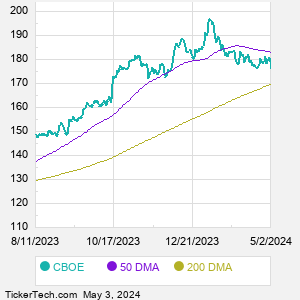Cboe Global Markets is an exchange holding company. Co. provides trading across a diverse range of products in multiple asset classes and geographies, including options, futures, U.S. and European equities, exchange-traded products, global foreign exchange and multi-asset volatility products based on the VIX Index. Co. operates in five segments: Options, U.S. Equities, Futures, European Equities and Global FX. Co. also provides trading in products and licenses based on its proprietary indexes and index methodologies, including volatility index products based on various broad-based market indexes, volatility indexes based on ETFs and individual stocks and options strategy benchmarks.
When researching a stock like Cboe Global Markets, many investors are the most familiar with Fundamental Analysis — looking at a company's balance sheet, earnings, revenues, and what's happening in that company's underlying business. Investors who use Fundamental Analysis to identify good stocks to buy or sell can also benefit from CBOE Technical Analysis to help find a good entry or exit point. Technical Analysis is blind to the fundamentals and looks only at the trading data for CBOE stock — the real life supply and demand for the stock over time — and examines that data in different ways. One of those ways is to calculate a Simpe Moving Average ("SMA") by looking back a certain number of days. One of the most popular "longer look-backs" is the CBOE 200 day moving average ("CBOE 200 DMA"), while one of the most popular "shorter look-backs" is the CBOE 50 day moving average ("CBOE 50 DMA"). A chart showing both of these popular moving averages is shown on this page for Cboe Global Markets. Comparing two moving averages against each other can be a useful visualization tool: by calculating the difference between the CBOE 200 DMA and the CBOE 50 DMA, we get a moving average convergence divergence indicator ("CBOE MACD"). The CBOE MACD chart, in conjunction with the chart of the moving averages, basically helps in visualizing how the moving averages are showing convergence (moving closer together), or divergence (moving farther apart). |



